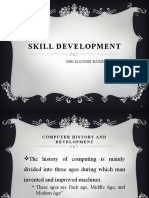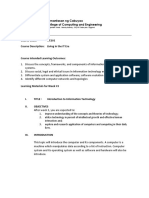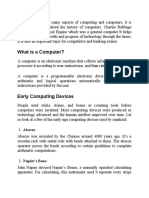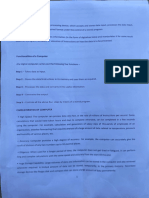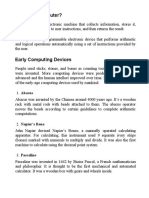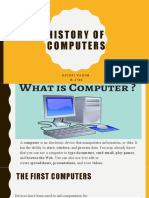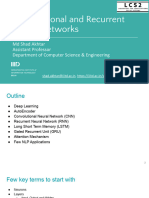ICT
EARLY COMPUTATIONAL TOOLS.
Introduction: The evolution of computational tools has significantly influenced human progress,
enabling more efficient calculations and data processing. How we do math and work with data has
come a long way and really changed things! Way back when, people used simple tools to help them.
These tools, from basic counting stuff to the first machines, paved the path for the computers we have
now.
1. Abacus (2300 BC): Talk about old-school! The abacus is one of the first calculators ever. It had a
frame with beads on rods. Each bead meant a different value. By moving the beads around, people
could do math problems. It helped with tough calculations and was also a great way to teach kids how
to count.
2. Napier's Bones (1617): John Napier, who was a Scottish mathematician, came up with Napier's
Bones. Think of them as rods with multiplication tables on them. They made multiplication and division
easier by turning them into simple addition and subtraction using logarithms. This was a big deal
because it made doing calculations by hand way less of a pain, especially for things like astronomy and
figuring out where you were when sailing.
3. Slide Rule (1620s): Taking Napier's idea of logarithms a step ahead, William Oughtred, an English
mathematician, invented the slide rule in the 1620s. It's basically a mechanical tool where you slide a
piece in between two marked rulers to line up numbers and do quick calculations. People used the
1|Page
�slide rule all the time for stuff like multiplication, division, square roots, and even trig functions. It was
a go-to tool for a long time until electronic calculators came along.
4. Pascaline (1642): Blaise Pascal, a French mathematician, invented this early calculator to help his
dad with tax stuff. It could add and subtract using gears and wheels, which was a big step forward for
computers. Even though it didn't do much, Pascal's Calculator showed that machines could do math
automatically.
5. Difference Engine (1822): Charles Babbage designed the Difference Engine to automatically
calculate polynomial functions. It used a math method to produce correct math tables. Babbage never
finished it, but the Difference Engine's ideas influenced later computers.
6. Analytical Engine (1833): Charles Babbage also came up with the Analytical Engine, a more
advanced design with an arithmetic unit, control flow, and memory. People think of it as the first
design for a computer because it had elements found in today's computers. Though never finished,
the Analytical Engine's ideas have had a big effect on how computers are built.
In conclusion, these early tools show that people have always tried to improve computers, leading to
the advanced digital computers we use now. Each invention was based on what came before it,
helping computing technology slowly get better. Looking at this progress shows the cleverness and
determination that have driven tech progress over the years.
HISTORY OF COMPUTERS
The evolution of computers is categorized into five distinct generations, each marked by
significant technological advancements that have progressively enhanced computing
capabilities. Below is an overview of these generations
1. First Generation (1940s–1956): Vacuum Tube-Based Computers
2|Page
� Technology: Utilized vacuum tubes for circuitry and magnetic drums for memory
storage.
Characteristics:
o Large physical size.
o High power consumption.
o Generated significant heat, leading to frequent malfunctions.
o Programming was conducted using machine language.
o
Notable Examples:
o ENIAC (Electronic Numerical Integrator and Computer): Completed in
1945, ENIAC was the first general-purpose electronic digital computer,
capable of performing a wide range of calculations. to calculate artillery firing
tables for the Army during World War II, enabling faster and more accurate
ballistic trajectory calculations than previous methods.
o UNIVAC I (Universal Automatic Computer I): Introduced in 1951,
UNIVAC I was the first commercially produced electronic computer in the
United States, it was designed for business and administrative applications.
2. Second Generation (1956–1963): Transistor-Based Computers
Technology: Replaced vacuum tubes with transistors, leading to more reliable and
efficient systems.
Characteristics:
o Smaller physical size.
o Increased processing speed.
o Reduced power consumption.
o Introduction of assembly language programming, offering a more user-
friendly interface compared to machine language.
Notable Examples:
o IBM 7090: A transistorized version of the IBM 709, used for scientific and
business applications.
o DEC PDP-1 (Programmed Data Processor-1): Released in 1960, it was one
of the first minicomputers, making computing more accessible to smaller
businesses and research institutions.
3. Third Generation (1964–1971): Integrated Circuit-Based Computers (IC)
Technology: Integrated circuits (ICs) combined multiple transistors onto a single
chip, further enhancing performance and reliability.
Characteristics:
o Significant reduction in size and cost.
o Enhanced processing speed and efficiency.
o Introduction of operating systems, allowing multiple applications to run
concurrently.
o Use of high-level programming languages like COBOL and FORTRAN.
Notable Examples:
o IBM System/360: Launched in 1964, it was a family of mainframe computer
systems designed to cover a complete range of applications.
o DEC PDP-8: Introduced in 1965, it is considered the first successful
commercial minicomputer, widely used in both business and research.
3|Page
�4. Fourth Generation (1971–Present): Microprocessor-Based Computers
Technology: Incorporated microprocessors, integrating the CPU onto a single chip,
leading to the development of personal computers.
Characteristics:
o Further miniaturization and reduction in cost.
o Introduction of graphical user interfaces (GUIs).
o Development of networking capabilities, facilitating the growth of the internet.
o Emergence of portable computing devices, such as laptops and early mobile
devices.
Notable Examples:
o Intel 4004 Microprocessor: Released in 1971, it was the first commercially
available microprocessor, marking a significant milestone in computing
history.
o Apple II: Introduced in 1977, it was among the first successful personal
computers, featuring color graphics and an open architecture.
5. Fifth Generation (Present–Beyond): Artificial Intelligence-Based Computers
Technology: Focus on artificial intelligence (AI), machine learning, and advanced
parallel processing.
Characteristics:
o Development of systems capable of natural language processing, pattern
recognition, and autonomous decision-making.
o Integration of AI in various applications, including virtual assistants,
recommendation systems, and autonomous vehicles.
o Emphasis on quantum computing research, aiming to solve complex problems
beyond the capabilities of classical computers.
Notable Examples:
o IBM Watson: An AI system known for winning the quiz show "Jeopardy!" in
2011, demonstrating advanced natural language processing and information
retrieval capabilities.
o Google DeepMind's AlphaGo: An AI program that defeated world
champions in the complex board game Go, showcasing the potential of deep
learning algorithms.
These generational advancements highlight the rapid evolution of computer technology,
transitioning from large, room-sized machines to the compact, intelligent systems integral to
modern life.
Basic Concepts of ICT
ICT (Information and Communication Technology)
Information and Communication Technology (ICT) refers to the use of technology to handle
telecommunications, broadcast media, audio-visual processing and transmission systems and
network-based control and monitoring functions. In simpler terms, ICT includes all devices,
networks, applications, and systems used to manage and communicate information. This
technology involves both the infrastructure for managing data and the tools used to
communicate information between people or systems.
4|Page
�Types of ICT Tools
ICT tools are broadly categorized into hardware and software. ICT tools allow users to
perform a wide range of tasks related to information processing, communication, and storage.
a. Hardware Tools
Hardware refers to the physical components of a computer system and other related devices
that we can physically touch and see.
Examples of hardware tools:
Input Devices: These devices allow users to provide data or commands to a computer
system.
o Keyboard: Used to input text and data.
o Mouse: Used to interact with graphical user interfaces.
o Scanner: Used to convert physical documents into digital formats.
o Microphone: Used to capture sound for input.
Output Devices: These devices display or produce the results of data processing.
o Monitor: Displays text, images, and videos.
o Printer: Produces hard copies of digital content.
o Speakers: Output sound from a computer.
Storage Devices: These are used to store data and programs.
o Hard Drive (HDD): Primary storage device used in most computers.
o Solid-State Drive (SSD): Faster and more reliable storage compared to
traditional hard drives.
o USB Flash Drive: Portable storage device for transferring files between
computers.
o Optical Discs (CDs/DVDs): Storage medium for digital files (though less
common now).
Processing Devices: These are the components that execute instructions and process
data.
o Central Processing Unit (CPU): The “brain” of the computer, responsible for
executing instructions.
o Graphics Processing Unit (GPU): A specialized processor used for handling
graphic and visual data.
b. Software Tools
Software refers to the set of instructions or programs that tells the computer's to perform
specific tasks. Software is grouped into two broad groups: system software and application
software.
Examples of System software tools:
System Software: this Controls and manages hardware components and provides a
platform for running application software. Examples of system software;
o Operating Systems (OS): Examples include Windows, macOS, Linux, and
Android, which manage hardware resources and provide a user interface.
5|Page
� o Device Drivers: Programs that allow the operating system to interact with
hardware devices (e.g., printer drivers, graphics card drivers).
o
Application Software: these are Programs designed to perform specific tasks
o Word Processors: Microsoft Word, Google Docs.
o Spreadsheets: Microsoft Excel, Google Sheets.
o Web Browsers: Google Chrome, Mozilla Firefox.
o Graphic Design Software: Adobe Photoshop, GIMP.
o Media Players: VLC, Windows Media Player.
o Anti virus: to detect and remove the viruses
Essential Hardware and Software Components of a Computer System
a. Hardware Components:
The hardware components of a computer system work together to perform the tasks necessary
for operation. These components are generally grouped as input devices, output devices,
storage devices, and processing devices.
Input Devices: These allow users to send data or commands into a system. Examples
include:
o Keyboard: To input text.
o Mouse: To navigate graphical user interfaces.
o Scanner: To convert physical documents to digital format.
o Microphone: To capture audio input.
Output Devices: These provide the results of processed data. Examples include:
o Monitor: Displays visual output from the computer.
o Printer: Converts digital information into a physical format.
o Speakers: Output sound from the system.
Processing Devices: These are responsible for processing instructions and data.
o CPU: Central unit that executes program instructions and manages data
processing.
o GPU: Specialized processor for handling graphic and video rendering tasks.
Storage Devices: These devices store data, whether temporarily or permanently.
o Hard Disk Drive (HDD): The primary storage device for long-term storage of
files and programs.
o Solid-State Drive (SSD): Faster storage option than HDD.
o USB Flash Drive: Portable storage for transferring files.
o Optical Discs (CD/DVD): Storage medium for data.
b. Software Components:
Software is essential for controlling hardware and enabling users to interact with the system.
Key components include:
System Software:
o Operating System (OS): Manages hardware resources and provides an
interface for users. Examples: Windows, macOS, Linux.
o Utility Programs: Software that performs maintenance tasks such file
management, etc.
6|Page
� Application Software: Programs designed to perform specific tasks for the user.
Examples include:
o Productivity Software: Word processors, spreadsheets, and presentation
software.
o Multimedia Software: Video editors, graphic design software, and music
players.
o Web Browsers: Tools for navigating the internet.
Hardware and Software
Hardware: Refers to the physical devices that make up a computer system, including
input, output, storage, and processing devices.
Software: Refers to the set of instructions or programs that tell the hardware how to
perform tasks.
Examples of Hardware and Software
Examples of Hardware:
o Keyboard (input device)
o Monitor (output device)
o Hard Drive (storage device)
o CPU (processing device)
Examples of Software:
o Microsoft Word (application software)
o Windows OS (system software)
A Computer
A computer is an electronic device that processes data and performs tasks according to a set of
instructions (programs). A computer is made up of hardware and software components that
work together to perform tasks such as calculations, data storage, and communication. In other
words, a computer is an electronic device that inputs, process, store and output data.
Block diagram of computer processing
INPUT OUTPUT
PROCESS
STORAGE
7|Page
� Input Devices:
These are Devices that allow data to be entered into a computer system. Examples include:
o Keyboard: For text input.
o Mouse: For pointing and selecting.
o Scanner: For scanning images and documents into a computer.
o Microphone: For audio input.
Output Devices
These are Devices that displays the results of processed data. Examples include:
o Monitor: Displays visual information such as text, images, and videos.
o Printer: Produces hard copies of documents.
o Speakers: Output sound, often from multimedia content.
Processing Devices:
These are Devices responsible for executing instructions and manipulating data. Examples
include:
o CPU: Executes program instructions.
o GPU: Renders graphics and video.
Storage Devices:
These are Devices that store data for future access. Examples include:
o Hard Disk Drive (HDD): Provides long-term storage.
o Solid-State Drive (SSD): A faster and more reliable storage medium than
HDD.
o USB Flash Drive: Portable data storage.
o Cloud Storage: Remote storage accessible via the internet.
8|Page
� Summary of a computer
COMPUTER
hardware software
EXAMPLES
. MOUSE
Application System software
MONITOR software
KEYBOARD ETC
EXAMPLES
OPERATING
. ANTIVIRUS UTILITY
SYSTEM
. MICROSOFT
WORD EXAMPLES
. MICROSOFT . WINDOWS
SPREADSHEET . LINUX
. UBUNTU
. Macintosh
COMMUNICATION TOOLS
9|Page

